
Ayutthaya Historical Park covers the ruins of the old city of Ayutthaya, Phra Nakhon Si Ayutthaya Province, Thailand. The city of Ayutthaya was founded by King Ramathibodi I in 1351, though it is likely to be significantly older, based on evidence showing that the area was already populated during the Mon Dvaravati period. Sources further mention that around 850 AD, the Khmers occupied the area and established a stronghold there, naming it Ayodhya, after one of the holiest Hindu cities in India of the same name. The early history of Ayutthaya is connected to this Khmer settlement. Additionally, Prince Damrong has also attested to the existence of a city named Ayodhya, founded by the Khmers ruling from Lopburi at the point where the three rivers meet. An excavation map shows traces of an ancient baray close to the southwestern tip of Wat Yai Chai Mongkhon, which could have been built on a former important Khmer temple complex.

A mudra is a symbolic or ritual gesture or pose in Hinduism, Jainism and Buddhism. While some mudras involve the entire body, most are performed with the hands and fingers.

Thai art refers to a diverse range of art forms created in Thailand since prehistoric times to the present day, including architecture, sculpture, painting, textiles, decorative arts, crafts, ceramics, and more. While Buddhism has played a significant role in Thai art, with many sculptures and paintings depicting Buddha images and religious themes, nature, including flora and fauna, as well as mythical creatures, has been a major inspiration for Thai art, with colorful motifs appearing in various types of art forms. In contemporary Thai art, traditional works remain significant and continue to influence artists' concepts.

Much Buddhist art uses depictions of the historical Buddha, Gautama Buddha, which are known as Buddharūpa in Sanskrit and Pali. These may be statues or other images such as paintings. The main figure in an image may be someone else who has obtained Buddhahood, or a boddhisattva, especially in the various traditions of Mahayana Buddhism. Other Buddhas and bodhisattvas in art have become increasingly common over the centuries, perhaps now outnumbering images of the historical Buddha.
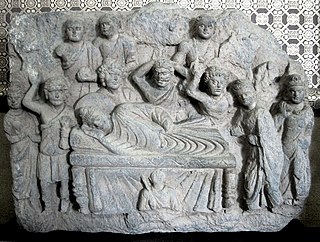
A reclining Buddha is an image that represents Buddha lying down and is a major iconographic theme in Buddhist art. It represents the historical Buddha during his last illness, about to enter the parinirvana. He is lying on his right side, his head resting on a cushion or relying on his right elbow, supporting his head with his hand.

The iconography of Gautama Buddha in Laos and Thailand recall specific episodes during his travels and teachings that are familiar to the Buddhists according to an iconography with specific rules. The Buddha is always represented with certain physical attributes, and in specified dress and specified poses. Each pose, and particularly the position and gestures of the Buddha's hands, has a defined meaning which is familiar to Buddhists. In other Buddhist countries, different but related iconography is used, for example the mudras in Indian art. Certain ones of these are considered particularly auspicious for those born on particular days of the week.

Nan is a town in northern Thailand. It is 688 km (428 mi) north of Bangkok. It is in the centre of Nan Province which bears its name, and of which it is the former administrative capital. It covers tambon Nai Wiang and parts of tambon Pha Sing of Mueang Nan District, an area of 7.60 km2 (2.93 sq mi) divided into 30 chumchon. In 2010 it had a population of 21,333 spread along the Nan River's right bank. Nan is a small city, primarily devoted to commercial, administrative, educational, and hospital activities. The old heart of the city, where Wat Phumin, the national museum and other tourist attractions are found, is being restored.
Yantra tattooing or Sak Yant is a form of tattooing sometimes using Indian yantra designs. It consists of sacred geometrical, animal and deity designs accompanied by Pali phrases that are said to offer power, protection, fortune, charisma and other benefits for the bearer.

The lands situated in the present-day Phitsanulok Province of Thailand have been inhabited since the Stone Age, although the neolithic inhabitants of the region are not likely to have been the ancestors of the modern Thai people who reside there today. The earliest historical records relating to what is now Phitsanulok Province indicates that at a time prior to or during the 11th century, the present-day city of Phitsanulok was but a small strategic Khmer outpost known as Song Khwae. During the next century, in 1188, Nakhon Thai, located near the center of the present Phitsanulok Province, was established as the capital city of the Singhanavati Kingdom, an early city-state of Thailand. Later, during Thailand's Sukhothai Period, the city of Phitsanulok emerged as a major city in the east of the Sukhothai Kingdom, and the great temples of Wat Chula Manee, Wat Aranyik and Wat Chedi Yod Thong were constructed. In 1357, the renowned Wat Phra Sri Rattana Mahathat was erected, and the Ayutthaya Period witnessed the construction of several of the province's other chief temples. Phitsanulok served for 25 years as the capital city of the Ayutthaya Kingdom. In 1555, King Naresuan the Great was born in the city of Phitsanulok. Naresuan played a significant role in the history of Thailand, as he expanded the kingdom to its greatest territorial extent, by conquering sizable portions of modern-day Burma and Cambodia. In recent times, Phitsanulok Province has become an important agricultural center, part of the Bread Basket of Thailand, providing rice and other crops to consumers in Thailand and throughout the world. Extensive agricultural development over the last hundred years or so has spawned a modern infrastructure in the urban areas of the province, bringing with it an array of modern roads, universities, hospitals and other conveniences. Over the years, the Nan River and its tributaries have played a substantial role in the history and development of the region by providing a route for transportation, fertile soil for agriculture, and water for irrigation. The river waters have also served as a route for enemy invaders, and have been the source of periodic widespread flooding throughout the province.
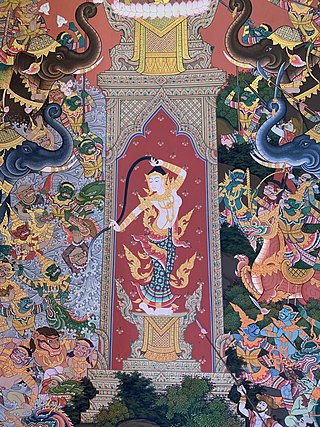
Vasundharā or Dharaṇī is a chthonic goddess from Buddhist mythology of Theravada in Southeast Asia. Similar earth deities include Pṛthivī, Kṣiti, and Dharaṇī, Vasudhara bodhisattva in Vajrayana and Bhoomi devi and Prithvi in hinduism.
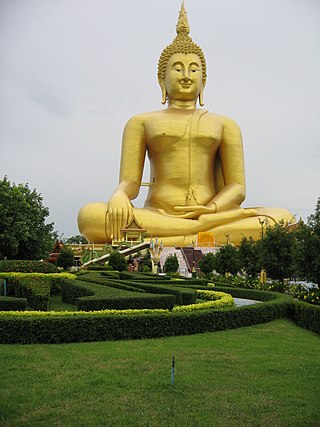
The Big Buddha of Thailand, also known as The Great Buddha, The Big Buddha of Thailand, Phra Buddha Maha Nawamin, and Mahaminh Sakayamunee Visejchaicharn, was in November 2018 the tallest statue in Thailand, the second tallest statue in Southeast Asia, and the ninth-tallest in the world.

Dvaravati art is a form of artistic work originating from Mon. Dvaravati flourished from the Dvaravati Mon ancient artifacts are in present-day Thailand and Burma, Mon states to the west in southern Myanmar (Burma) and with the Mon state in northern Thailand. Dvaravati experienced political domination by neighbouring peoples on three occasions: in the 10th century, when the Burmese conquered the Mon state of Thaton west of the Tenasserim Yoma; from the 11th to the 13th century, when the Khmer Empire (Cambodia) arose in the east; and finally, in the late 13th century, when Dvaravati was absorbed by the Thai empire.
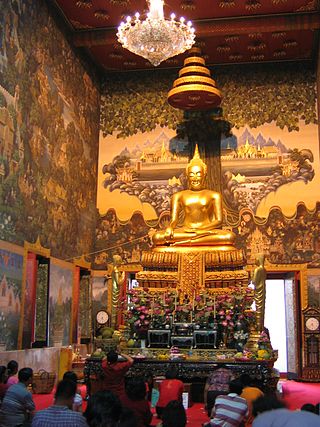
Wat Rai Khing is another prominent and notable temple in Nakhon Pathom province in addition to Wat Phra Pathom Chedi, which is the provincial temple. Wat Rai Khing is located along the Tha Chin River, Tambon Rai Khing, Sam Phran district on Petchkasem Road, west of Bangkok. And not far from other attractions such as Sampran Riverside, Samphran Elephant Ground & Zoo etc.

Māravijaya attitude is an attitude of Buddha in Thai art of which the seated Buddha is putting his hand in the relax posture towards to the ground, loosely holding his knee. The other hand is on his lap. His eyes, sometimes closed, look down to the ground. The gesture of the hand reaching the ground is called bhumisparshamudra, which also refers to the attitude as well. The gesture refers to the episode which the Buddha calling the earth to witness.

The meditation attitude, also known as meditating Buddha, is an attitude of Buddha in which the seated Buddha rests both upturned hands on his lap, the right hand usually on top. His eyes are closed. The attitude refers to an episode where he reached enlightenment, meditating in this posture under the Bodhi tree.

Naga Prokattitude (Thai: ปางนาคปรก; RTGS: pang nak prok), translated as "sheltered-by-the-naga Buddha", is an attitude of Buddha in Burmese, Khmer, Lao and Thai art in which the Buddha, seated in either the meditation or maravijaya attitude, is sheltered by or covered with a multi-headed nāga. The nāga, whose name is Mucalinda, usually has seven or nine heads and appeared to coil the base of the Buddha statue.
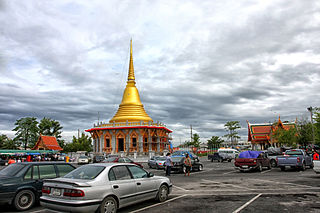
Wat Bang Phli Yai Nai is a Thai Buddhist temple in the area of Bang Phli Yai Subdistrict, Bang Phli District, Samut Prakan Province, outskirts Bangkok.
Na Chom Thian or Na Jomtien is a town and tambon (subdistrict) in Sattahip District of Chon Buri Province, on the southern fringe of Pattaya. It is known for its attractions Nong Nooch Tropical Garden, Wat Yanasangwararam, Buddha Mountain, natural parks and sandy beaches.
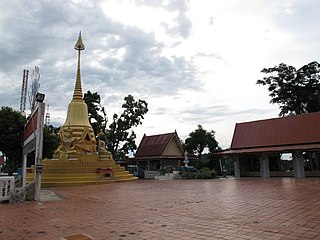
Wat Woranat Banphot also colloquially known as Wat Khao Kob (วัดเขากบ) is an ancient Buddhist temple in Mahā Nikāya sect, regarded as one of the famous and well-known temples of Nakhon Sawan Province.






















